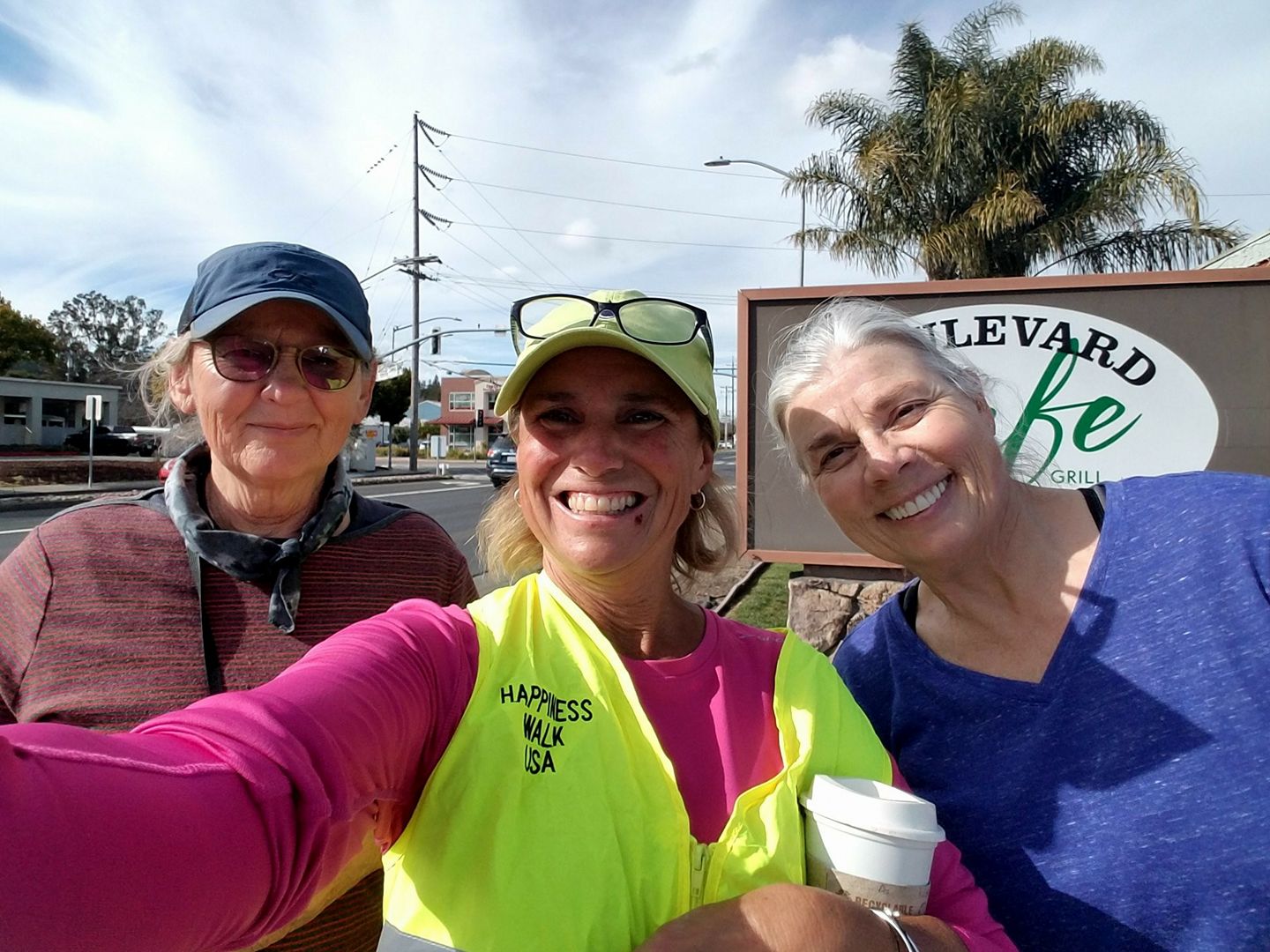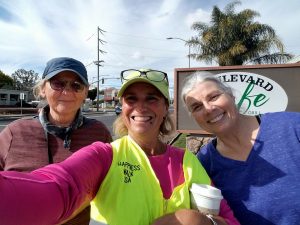
The Science of Happiness Walking: Gross National Happiness USA visits Happy Brain Science
This Wednesday’s blog is actually from a guest author: the president of Gross National Happiness USA (GNHUSA), Ginny Sassaman,. GNHUSA strives to make happiness our new bottom line in America. They work to increase personal happiness and our collective wellbeing by changing how we measure progress and success. At Happy Brain Science we are delighted to have them share some wisdom with us and with you. For those in Portland, OR, you can join Happy Brain Science and GNHUSA at a free event at HatchLab PDX, 2420 NE Sandy Blvd, on Wednesday April 25th, 2018 from 4:30 until about 6PM. Come learn about–and participate in–their work with us!
Happiness walks from Vermont to Portland, OR!
When the residents of Portland, Oregon–or any of the other cities on Leg 13 of the Happiness Walk–see Paula Francis and other walkers in their neon “Serious About Happiness” vests, they will likely not realize that they are witnessing a wide-ranging research project. They also won’t know that the Walk in front of them originated in Stowe, Vermont and has logged nearly 6,000 miles on foot so far — unless they stop and engage in conversation with the walkers. They might even agree to become research participants themselves by answering one fundamentally important question: “What matters most in life to you?”
To date, the Walk has conducted many thousands of these interviews; Gross National Happiness USA (GNHUSA) is in the process of transcribing and analyzing the data from the Walk’s earlier days. Those of us who’ve walked know that the overwhelming answer for Americans of all stripes is some form of relationship and love. But we also know that regional differences are likely to emerge on various themes.
Take religion and spirituality as an example. When I joined Paula for several weeks in the Jacksonville, Florida area, there was an emphasis on Jesus. In Louisiana, I noted a general talk about religion but it was more Catholic in tone and less specifically focused on Jesus. Then in Santa Fe, the talk shifted to more of a mindfulness-centered spirituality. Who knows what will show up in interviews when I join the Happiness Walk again in Portland?
Walking for data; listening to the data

The data will tell us! As Carl Polley, PhD, an instructor at Kapi’olani Community College in Honolulu, and a new member of the GNHUSA advisory board notes,”The data collected via Happiness Walk interviews serves as a valuable record of how individuals in many different areas across the United States think about and talk about happiness.”
So why are we walking all these miles and asking so many people the same question? Particularly given the amount of research over the last few years on the science of personal happiness?
Bhutan, Gross National Happiness, and you
The answer lies, at least to start, in Bhutan. In 2008, when Bhutan methodically set about creating a Gross National Happiness system to measure collective well-being, they surveyed all Bhutanese citizens to determine what actually made them happy. Using this data, the Centre for Bhutan Studies developed nine domains where optimal happy-making conditions could be supported by government policy. It’s even part of Bhutan’s constitution: “the State shall strive to promote those conditions that will enable the pursuit of Gross National Happiness.”
The Bhutanese research was exhaustive: six hour interviews with every citizen! From those interviews they determined nine domains:
- psychological well being
- material well being
- good governance
- health
- community vitality
- education
- cultural diversity and resilience
- balanced time use
- ecological diversity
In other words, a diverse set of holistic measures. Major decisions are run through an extensive grid measuring multiple factors within each domain to determine if a particular law or policy is likely to increase or decrease the people’s happiness.
A young movement that’s spreading
It’s still a young system, and movement. The entrenched obstacles are obviously significant – but GNH is spreading. Even the United Arab Emirates has a Minister of Happiness! Countries worldwide recognize the urgency in UN Secretary-General Ban Ki-moon’s message on happiness. He said,

“Happiness is neither a frivolity nor a luxury. It is a deep-seated yearning shared by all members of the human family. It should be denied to no-one and available to all. This aspiration is implicit in the pledge of the United Nations Charter to promote peace, justice, human rights, social progress and improved standards of life.
“Now is the time to convert this promise into concrete international and national action to eradicate poverty, promote social inclusion and inter-cultural harmony, ensure decent livelihoods, protect the environment and build institutions for good governance,” Ban Ki-moon continued. “These are the foundations for human happiness and well-being.”
We at GNHUSA wholeheartedly agree. The time is now, to use a holistic set of alternative indicators as the north star for personal and collective well being. But, what should those indicators look like here in the United States? We are a very different country from Bhutan — and obviously, no one in the United States is going to attempt six-hour interviews of every adult living here!
Data already collected at national and state levels
Laura Musikanski and other colleagues at the Happiness Alliance have been working on this question since 2011, and have compiled compelling data. GNHUSA, in collaboration with the Center for Rural Studies at University of Vermont and other partners in the Vermont Data Collaborative, has been doing the same thing on a localized Vermont level. That collaborative recently published its 2017 survey on happiness and well being in Vermont.
The Happiness Walk, with its multitude of transnational interviews, seeks to complement and build on research being done by others. Indeed, we are even complementing our own Walk data with an online survey on our website. Click here and add your voice to the research!
Micro bursts of love, one step at a time
There is another interesting scientific aspect to the Walk: “micro bursts of love.” We get that term from Barbara Frederickson, Ph.D. She is the Kenan Distinguished Professor of Psychology and the

principal investigator of the Positive Emotions and Psychophysiology Lab at the University of North Carolina, Chapel Hill. She is also the former president of the International Positive Psychology Association. Suffice it to say, she’s a leading light in the positive psychology research world. In the Daily Good, Frederickson wrote:
“Love, as your body experiences it, is a micro-moment of connection shared with another. And decades of research now shows that love, seen as these micro-moments of positive connection, fortifies the connection between your brain and your heart and makes you healthier. […] It can seem surprising that an experience that lasts just a micro-moment can have any lasting effect on your health and longevity. Yet there’s an important feedback loop at work here, an upward spiral between your social and your physical well-being. That is, your micro-moments of love not only make you healthier, but being healthier also builds your capacity for love. Little by little, love begets love by improving your health. And health begets health by improving your capacity for love.”
On the Happiness Walk, we experience frequent micro bursts of love. These moments seem magical. In reality, they spring from the connecting power of listening. We listen with open minds and hearts to what matters most in people’s lives. We aren’t asking for money, or votes. Proselytizing? No thanks! We’re just listening. The interviewees, in turn, open their hearts and minds, and from their mouths flow the most amazing stories and poignant observations. We all fall in love with each other. Then we say goodbye and continue on our separate journeys.
A walk full of hope for a new paradigm
So this a quest full of hope. The Walk directly engages the public in building awareness and support for a new paradigm. That new paradigm will steer individual decision making and public policy making away from the grip of GDP to focus instead on true well-being for all. We know that we can do better. With love and research, we will. One step at a time.